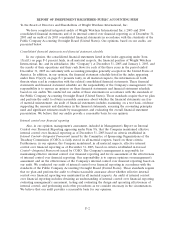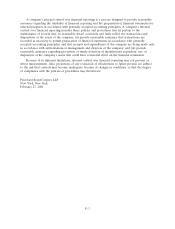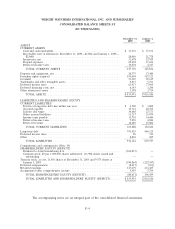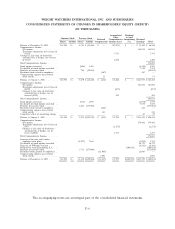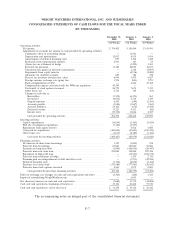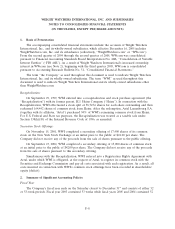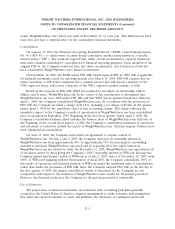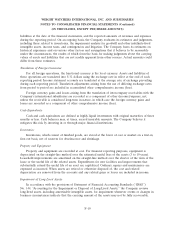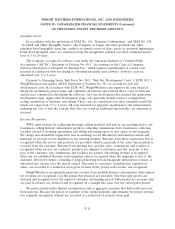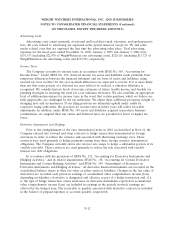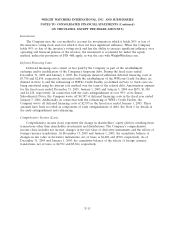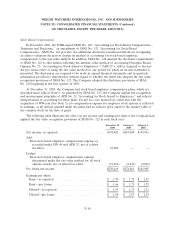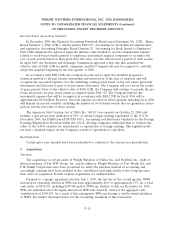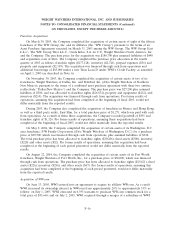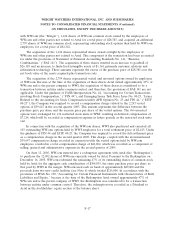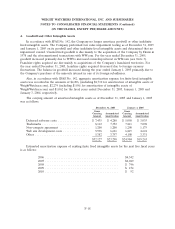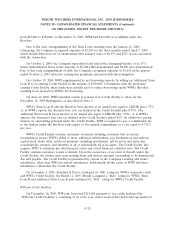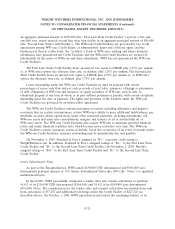WeightWatchers 2005 Annual Report Download - page 88
Download and view the complete annual report
Please find page 88 of the 2005 WeightWatchers annual report below. You can navigate through the pages in the report by either clicking on the pages listed below, or by using the keyword search tool below to find specific information within the annual report.WEIGHT WATCHERS INTERNATIONAL, INC. AND SUBSIDIARIES
NOTES TO CONSOLIDATED FINANCIAL STATEMENTS (Continued)
(IN THOUSANDS, EXCEPT PER SHARE AMOUNTS)
Advertising Costs:
Advertising costs consist primarily of national and local direct mail, television, and spokesperson’s
fees. All costs related to advertising are expensed in the period incurred, except for TV and radio
media related costs that are expensed the first time the advertising takes place. Total advertising
expenses for the fiscal years ended December 31, 2005, January 1, 2005 and January 3, 2004 were
$151,533 (including $22,478 of WeightWatchers.com advertising costs), $128,116 (including $13,723 of
WeightWatchers.com advertising costs) and $107,931, respectively.
Income Taxes:
The Company accounts for income taxes in accordance with SFAS No. 109, ‘‘Accounting for
Income Taxes.’’ Under SFAS No. 109, deferred income tax assets and liabilities result primarily from
temporary differences between the financial statement and tax bases of assets and liabilities, using
enacted tax rates in effect for the year in which differences are expected to reverse. If it is more likely
than not that some portion of a deferred tax asset will not be realized, a valuation allowance is
recognized. We consider historic levels of income, estimates of future taxable income and feasible tax
planning strategies in assessing the need for a tax valuation allowance. We also establish an appropriate
level of additional provisions for income taxes in the event that certain positions, which we believe are
fully supportable, are challenged by the tax authorities. We adjust these additional provisions in light of
changing facts and circumstances. If our filing positions are ultimately upheld under audits by
respective taxing authorities, the provision for income taxes in future years will reflect favorable
adjustments. In addition, under SFAS No. 109 assets and liabilities acquired in purchase business
combinations are assigned their fair values and deferred taxes are provided for lower or higher tax
bases.
Derivative Instruments and Hedging:
Prior to the extinguishment of the euro denominated notes in 2004 (as described in Note 6), the
Company entered into forward and swap contracts to hedge transactions denominated in foreign
currencies in order to reduce the currency risk associated with fluctuating exchange rates. These
contracts were used primarily to hedge payments arising from those foreign currency denominated
obligations. The Company currently enters into interest rate swaps to hedge a substantial portion of its
variable rate debt. These contracts are used primarily to reduce the risk associated with variable
interest rate debt obligations.
In accordance with the provisions of SFAS No. 133, ‘‘Accounting for Derivative Instruments and
Hedging Activities,’’ and its related amendments, SFAS No. 138, ‘‘Accounting for Certain Derivative
Instruments and Certain Hedging Activities’’ and SFAS No. 149, ‘‘Amendment of Statement on
Derivative Instruments and Hedging Activities,’’ all derivative financial instruments are recorded on the
consolidated balance sheets at their fair value as either assets or liabilities. Changes in the fair value of
derivatives are recorded each period in earnings or accumulated other comprehensive income (loss),
depending on whether a derivative is designated and effective as part of a hedge transaction and, if it
is, the type of hedge transaction. Gains and losses on derivative instruments reported in accumulated
other comprehensive income (loss) are included in earnings in the periods in which earnings are
affected by the hedged item. The receivable or payable associated with derivative contracts is included
in the balance of prepaid expenses or accounts payable, respectively.
F-12


